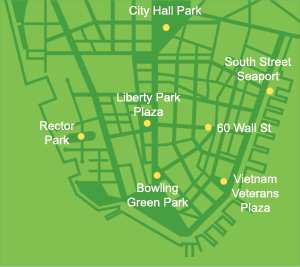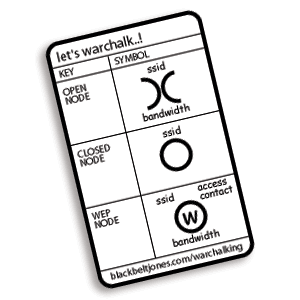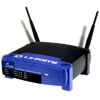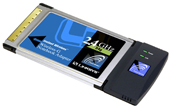What is WiFi?
WiFi is a wireless LAN: data transfer via radio instead of using wires.
Unlike satellite equipment (GPS, Iridium) which works worldwide,
or cellular phones which works with ranges of miles,
the radio signals are intentionally weak so it reaches only within a room or a floor
(and many other reasons: to avoid interference with others, avoid FCC licensing for the transmitter, longer battery life).
Devices rarely work alone.
The Palm Pilot pioneered the "always ready, always in your pocket" concept.
With "hotsync" and "beaming" it loves to share its data so it naturally finds collaborative roles with other devices.
As computing and recording devices become ubiquitous, our needs and expectations rise.
Sharing information is a key element, and WiFi can help!
The lovely thing about standards is that there are so many from which to choose!
-
IEEE standard protocols for wireless data
http://grouper.ieee.org/groups/802/
-
802.11a: operates at 5 GHz, data up to 54 Mb/s, 25-75 foot indoor range
The 5 GHz band is uncrowded, less interference. -
802.11b: operates at 2.4 GHz, data rate of 11 Mb/s, 100-150 foot indoor range
The 2.4 GHz band may interfere with cordless phones, microwave ovens. etc. - 802.11g: 54Mbps Extension to 802.11b (operates at 2.4 GHz)
-
802.15: Wireless Personal Area Network (WPAN) consensus standards
for short distance wireless networks.
802.15.1 has derived a Wireless Personal Area Network standard based on the Bluetooth v1.1 Foundation Specification
-
802.11a: operates at 5 GHz, data up to 54 Mb/s, 25-75 foot indoor range
-
Bluetooth
http://www.bluetooth.com/
http://www.bluetooth.org/
Designed primarily for low power and low cost, Bluetooth achieves 1Mb/s and a range of 20m but it uses different frequencies and protocols better suited for synchronous voice as needed for cellular phone accessories. Certainly a step up from infra-red "beaming" which was more range and speed limited.
Named after Harald Bluetooth, the Danish king who unified Denmark and Norway in the 10th century
-
HiperLAN2 (High Performance Radio LAN)
http://www.hiperlan2.com/
HiperLAN, which comes in several flavors, is a next-generation, high-speed wireless LAN technology that offers end users throughputs as high as 42 Mbits/sec. Strong security is part of the design with DES/3DES.
Where is WiFi?
- right here at NJIT: in the classroom, downstairs too
http://telecom.njit.edu/mobile/
Mobile Network Documentation Page
http://telecom.njit.edu/wireless/
The Wireless Network is an extension of the NJIT Mobile network. Your notebook with wireless connection will only have access to basic network services until you use a valid UCID and UCID password to Authenticate.
- at home
Both the base units (hubs/switches) and NICs are affordable and ubiquitous enough that they're sold at Best Buy, Staple's and office superstores. Most manufacturers (Linksys, Belkin, Dlink) comform to the 802.11 standard so it's all compatible. Folks like it because there's no wire to maintain. Access can be extended to guests on a temporary or permanent basis, depending on the security in place.
- in hospitals
- testing wireless tablet PCs instead of clipboards
- voice over Wi-Fi to summon help: an evolution of voice over IP (article in June 2003 Wired)
- and integrated to location based services to find nearest specialist
this only adds to the confusion!
Cell phones are trying to be PDAs
PDAs have integrated cellular phones
now voice calls can choose cellular or VoIP (wired or wireless!)
- stores and warehouses
for hand held inventory devices and internal use
SECURITY PROBLEM: some wireless cash register had weak or no encryption, so credit card information was easily gathered from OUTSIDE the building!
- "hotspots" in stores, hotels, etc.
- INTENTIONAL hotspots
- fee based
in restaurants (Starbucks, Boarder's) and hotels: pay per hour, or via subscription
- free
 http://nycwireless.net/
http://nycwireless.net/
our mission: to provide free public wireless internet service in public spaces throughout New York City.
- fee based
- UNINTENTIONAL hotspots: "warchalking"
 http://en.wikipedia.org/wiki/Warchalking
http://en.wikipedia.org/wiki/Warchalking
http://www.warchalking.us/
http://www.blackbeltjones.com/warchalking/index2.html
Collaboratively creating a hobo-language for free wireless networking. Warchalking is the practice of marking a series of symbols on sidewalks and walls to indicate nearby wireless access. That way, other computer users can pop open their laptops and connect to the Internet wirelessly. It was inspired by the practice of hobos during the Great Depression to use chalk marks to indicate which homes were friendly.
- tech part: topologies, range
Most wifi networks are a "star" topology, relying on wires or other radio links to get to the servers or Internet.
Terms such as- 802.11b peering
- Parasitic grid
- neighborhood area networks
- Open Network Access Point
Specialized antennas help "focus" the signal for further reach without increased power. Properly used, a Pringles can is a cheap directinal antenna.
- INTENTIONAL hotspots
What equipment Do I need?
As a wireless user, your device (laptop, PDA, tablet-PC, Newton, Dick-Tracy watch, ...) must have a wireless network card that's compatible with the provider. Intel Centrino devices have that build in. Most others plug in a card.
Running your own wireless network requires more diligence than wired networks.
- hardware
Instead of hubs to wires to NICs, it's wireless hubs to wireless NICs.
The equipment is more expensive.
If the signal cannot reach all desired points then additional equipment is needed (an amplifier, more wireless hubs, etc). - software
in addition to the usual network concerns (what services to share, user ID mappings), there's additional burdeon to have security right from the start.

 http://linksys.com/
http://linksys.com/
 http://www.apple.com/airportexpress
http://www.apple.com/airportexpress
Apple's "AirPort Extreme" is the latest version of their wireless hub. It works at 54 Mbps using the IEEE 802.11g wireless draft specification and is still compatible with 802.11b. It supports 50 Mac and Windows users simultaneously
Industrial/commercial equipment tends not to be "pretty" but allows customization such as directional antennas, collaboration of hubs even when signals overlap, specialized test equipment to monitor, evaluate, tune or debug networks.
What's all the fuss about Centrino?
 MSN butterfly MSN butterfly
|
 Centrino moth Centrino moth
|
http://www.intel.com/products/mobiletechnology/
Intel's Centrino is a heavily advertised "technology".
The TV commercials are mostly pushing it as a new FEATURE. At this time, it's just a chipset that supports 802.11b (the slower speed). The main advantage is battery life for portable equipment and selling more Intel chips.
My personal bias aside, Intel did not rush to market with immature or uncertain technologies so they focused solely on 802.11b. They leveraged the Pentium processor technology to new a low power version (Pentium M) for mobile applications, and chip making is definitely Intel's strength.
WiFi Security
Despite the deliberate range limit of WiFi signals (no FCC license required),
radio signals propagate in strange and mysterious ways (just ask any HAM about
skip and other phenemona). Even users of free public acccess points deserve
privacy.
Encryption is the main technology, implemented as smartcards (such as cell phone's SIM), crypto-chips in the NIC (IPsec Network Card), or all software (SSL, SSH, PGP).
Wired Equivalent Privacy (WEP) is part of the 802.11b standard, but it is considered weak and insecure.
Citing reefedge's white paper on wireless LAN security:
- reliance on global (shared) keys complicates administration and introduces security exposures. The access point uses a single WEP key that is shared by all authorized mobile clients.
- insecure (weak) encryption algorithms make the LAN vulnerable to attack
- keys are too short
Proprietory solutions will always be available sooner since industry ratification takes time, so remain flexible!
To Learn More
http://www.80211hotspots.com/
lists mostly commercial hotspots
http://www.80211-planet.com/
802.11 trade shows, expos
http://www.reefedge.com/
White papers
http://www.proxim.com/
mfgr
http://www.boingo.com/
the provider of commercial Hot Spots such as Starbuck's, airports.
http://www.slackaction.com/signroll.htm
http://www.worldpath.net/~minstrel/hobosign.htm
http://www.thortrains.net/hobotalk.htm
Hobo Signs & Symbols
http://www.cs.bham.ac.uk/~rlc/warring/ipaqstumbling.html http://www.cs.bham.ac.uk/~rlc/warring/warring.html
how to warchalk in the UK
IEEE Spectrum: May 2003
article on Intel Centrino's launch
http://linksys.com/Products/wirelessstandards.asp
Compares 802.11 a/b/g